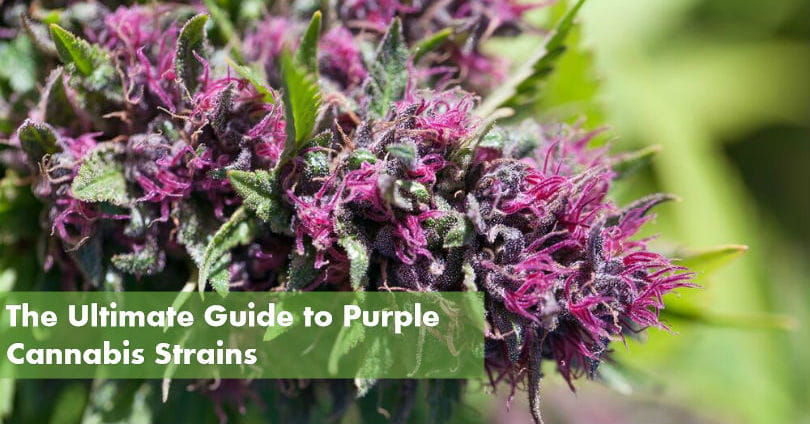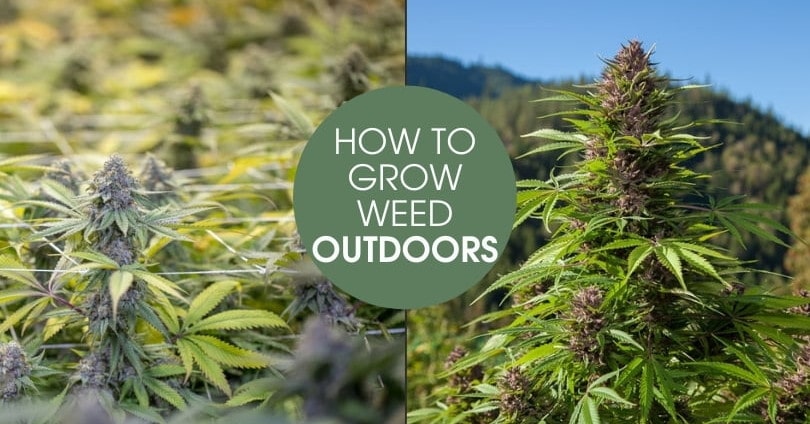 Water — the essential component of life.
Water — the essential component of life.
Although we all understand the importance of water, many new cannabis cultivators overlook irrigation methods, or worse yet — create watering strategies on the fly.
From overwatering to under-watering, watering marijuana plants is a balancing act. Furthermore, the interaction of water and nutrients creates an even deeper layer to the overall irrigation equation.
With so many types of methods to irrigate your cannabis crop, there’s no better time than now to dig in and learn the fundamentals of watering weed plants.
From overall plant health to the size of the final harvest — everything depends on H2O. Ready to master the art of irrigation? Let’s begin!
What is Irrigation and Why Does it Matter?
Irrigation is a fancy way to describe the act of watering plants; in this case — cannabis.
Overall, irrigation provides water and nutrients to the root zone of plants. Once the root system comes in contact with water, the roots absorb water and nutrient particles to fuel plant growth.
As you’ll soon discover, there’s a myriad of methods to provide water to your green beauties, such as:
- Hand-watering with a watering can
- Drip irrigation (above ground and underground)
- Hydroponic-specific (DWC, DTW, NFT)
- Foliar feeding
Suddenly, watering your weed plants doesn’t sound so basic, does it?
As for why watering cannabis plants matters — this is a no-brainer.
Your plants will die if you fail to water them. Whether you apply water via an underground drip line or foliar application — your cannabis plants need water to live.
Here’s a list of essential plant functions that require water, and subsequently, nutrient, to accomplish:
- Water transports nutrients
- Water allows photosynthesis to occur
- Water maintains plant cell turgidity
- Water converts starch to sugar
- Water enables transpiration
- Water regulates the temperature within plants
If we continue, this list may span the rest of the guide. In other words, water is a core component for cannabis plants to function correctly.
Ultimately, correctly watered marijuana plants:
- Grow quickly
- Produce strong stems and branches
- Yield massive buds
- Increase trichome production
- Increase the cannabinoid and terpene profile
As you can see, the simple act of watering your weed plants means life or death or the difference between a micro harvest and a record-breaking haul of bud.
With that in mind, we believe the choice is clear — learn how to water your cannabis plants for the best results possible!
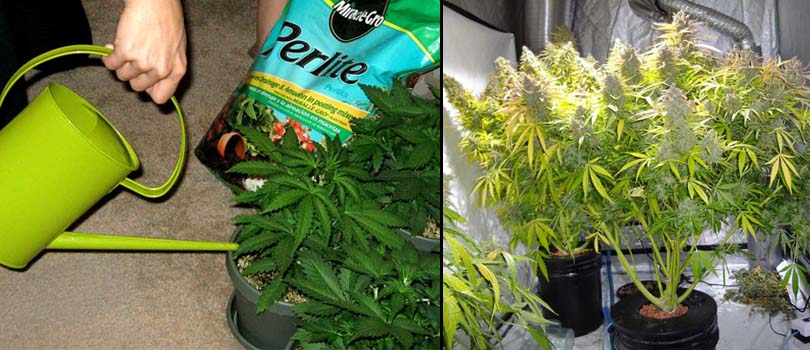
Watering cannabis can be as simple as watering by hand or using an advanced method like deep water culture.
Q: What is irrigation?
A: Irrigation is a fancy way to describe the act of watering plants. Irrigation provides water and nutrients to the root zone of plants. Once the root system comes in contact with water, the roots absorb water and nutrient particles to fuel plant growth.
The Shortcut to Watering Cannabis Plants Successfully
Now that you understand the overall importance of watering your weed crops — it’s time to learn the basics of weed irrigation.
We’ve taken all of the most popular questions and condensed them into a shortcut guide for beginners that need to step up their cannabis cultivation techniques.
When to Water Cannabis Plants
The age-old question — when should I water my weed plants?
Although we could answer this question by simply saying — when your weed plant looks thirsty — it wouldn’t be good enough.
So, let’s take an in-depth look at when to water your cannabis crop.
As with all things cannabis-related, there are many variables that you must consider — even when dealing with something as simple as watering your plant.
Therefore, here’s a list of aspects that you must consider when determining the perfect moment to water your marijuana plants.
- The temperature of the environment
- The humidity level
- The size of the cannabis plant
- Wind level or rate of airflow in the garden
Each of the aspects mentioned above influences your decision on when to water marijuana plants.
Therefore, what part of the day is the best time to water your stellar weed plants? Generally, the best time of the day to water outdoor cannabis plants is in the early morning.
For indoor cannabis crops, the best time to water is right after lights on.
The beginning of the day is the best time to water marijuana plants because it allows the root zone to soak up the water and nutrients before the heat of the day evaporates the water from the medium.
If you choose to water marijuana plants during the middle of the day (the hottest time of the day) — you will find yourself watering cannabis plants more often.

Temperature, humidity, wind level, and the size of your cannabis plant influences when you should water your beloved marijuana plant.
How Often To Water Marijuana Plants
The next logical point to clear up is how often to water weed plants.
Once again, critical environmental variables play a crucial role in determining how often to water cannabis plants, such as:
- The temperature of the environment
- The humidity level
- The size of the cannabis plant
- Wind level or rate of airflow in the garden
For example — if the temperature is high, such as 95°F on a summer afternoon, you’ll need to water your cannabis plant often. However, if you live in a location that experiences hot days and high humidity, you will not have to water so often because high humidity slows plant respiration.
In another example, too much airflow in the garden may result in rapid evaporation, forcing you to water often.
Lastly, a small cannabis plant consumes far less water than a seven-foot-tall cannabis tree. The size of a cannabis plant influences how often to water marijuana plants because of the root zone.
Remember, the bigger the roots — the more water necessary to keep your weed plants happy and hydrated.
Here’s a classic method to check if it’s time to water your potted cannabis plants.
How To Check If It’s Time To Water Indoor or Outdoor Potted Cannabis Plants Using The Weight Test
Are you ready to learn how to check if it’s time to water your potted cannabis plants? Whether you grow weed in coco coir or organic soil, the weight test is all you need.
To accomplish the weight test, all you need is:
- A scale
- Cannabis plant(s)
Now that you have these items let’s take a look at the steps to determine if it’s time to water your potted marijuana plants.
Step One
First, wait until the medium is reasonably dry and your marijuana plants look thirsty.
Step Two
Bring the scale and set it on a flat surface. Make sure the scale is calibrated correctly to ensure an accurate measurement.
Step Three
Place the potted cannabis plant on the scale and record the weight.

Step Five
Remove the plant and begin to water it until you notice a small amount of runoff.
Step Six
Once the plant is done producing runoff — re-weigh the container and record the new weight.
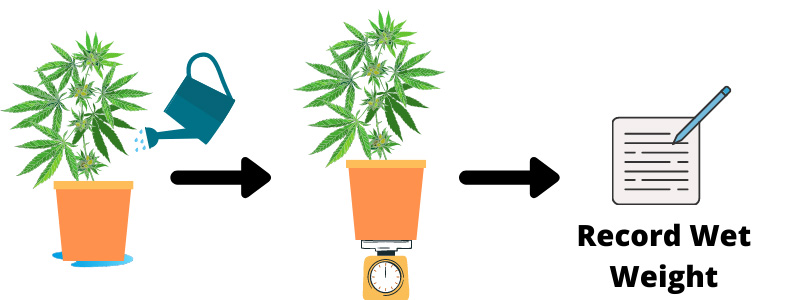
Step Seven
Lastly, subtract the watered weight from the dry weight. The number from this calculation is the weight of water that you need to water your cannabis plant. With the weight test, you don’t need to look for signs from the plant. Instead, you may now use weight as an optimal benchmark to water your cannabis plants.
Remember, this is a precise method to accomplish the weight test. If you’re pressed for time or don’t have access to a scale — worry not!
Instead, you may remember what the dry cannabis plant feels like, and once watered, you may gauge the difference. Overall, you may find yourself watering your cannabis plants once or more per day.
How Much Water To Water Cannabis Plants
Ok, now that you understand the best time of the day to water and how often — it’s time to learn how much water to give to marijuana plants.
As you must be accustomed by now, the quantity of water depends on specific variables, such as:
- The size of the cannabis plant
- Environmental conditions
- The size of the container (or root zone)
However, the answer to the quantity of water to apply to each cannabis plant depends.
In other words, you must figure this portion of the irrigation equation on your own. However, that doesn’t mean we’re going to leave you hanging. Here’s a simple method to determine how much water to give to marijuana plants.
How to Determine How Much Water to Give to Weed Plants In Three Steps
If you’re growing potted cannabis plants in soil, here’s the foolproof method to determine how much water to give to marijuana plants.
Step One
First, wait until the container is light in weight.
At this point, the upper layer of soil is dry, and you won’t feel any moisture as you dig your finger into the medium
Step Two
Take a watering can and slowly pour around the stem (not directly on it). Remember, don’t drain the watering can one fell swoop. Instead, allow the soil to absorb the moisture.
Step Three
Once the water begins to trickle from the bottom of the container slowly — stop watering!
When growing cannabis in soil, you don’t need to water until runoff. Therefore, you now have a baseline of how much water produces runoff. Now, you may scale the amount of water for subsequent waterings to ensure an optimized irrigation schedule.
Remember, you must use this method each time you increase container size. Furthermore, the amount of water used will increase as the cannabis plant grows in size.
pH Matters Depending on Your Medium
Remember our guide on pH and pH meters? Well, we’re returning to the subject because it’s an essential aspect to consider when watering your cannabis crop.
Depending on your medium, you may or may not have to pH the water.
Organic soil contains natural buffers, such as dolomite lime, that automatically adjust the pH. On the other hand, hydroponic-based media, such as clay pebbles or rockwool, require pH’d water.
By providing the right pH according to your medium — your cannabis plants will thrive.
Therefore, we recommend reading our guide on Why You Need to Use a pH Meter When Growing Weed in Hydroponics to learn more.

Depending on your medium, you may need to use a pH meter.
The Size of The Root Zone Matters
One interesting aspect that most grow guides fail to mention is the root zone influence.
The root zone isn’t just the mechanism that drains the medium of its water source. Instead, the root zone also acts as a buffer against drought.
Remember, the root zone is typically the same size as the visible plant. In other words, if the cannabis plant is six feet tall — you may assume that the root zone spans six feet.
Cannabis plants do not exhibit shallow roots. Therefore, the deeper the roots explore, the less likely they are to experience drought.
Once again, let’s take a look at the environmental factors that impact the watering cycle of cannabis plants to gain an in-depth understanding of the relationship between root size and drought tolerance.
- The temperature of the environment
- The humidity level
- Wind level or rate of airflow in the garden
As you can see, each of these environmental factors occurs above ground. Therefore, they impact the visible layer of cannabis plants.
Alternatively, young cannabis plants exhibit a small root zone, which means they are unlikely to sustain themselves without your intervention.
However, the deeper the roots — the less likely they will run out of water. If you’re still scratching your head regarding this concept, let’s use an outdoor cannabis plant that’s planted in the ground as an example.
A cannabis plant in the ground is free to roam, and the confines of a container do not contain its root system. The deeper the roots burrow, the more protected they are from the sun’s harsh rays and evaporation.
Therefore, an extensive root system provides:
- Longer intervals between waterings
- Added drought resistance
To sum everything up: the larger the root zone — the less watering frequency. The smaller the root zone — the higher the watering frequency.
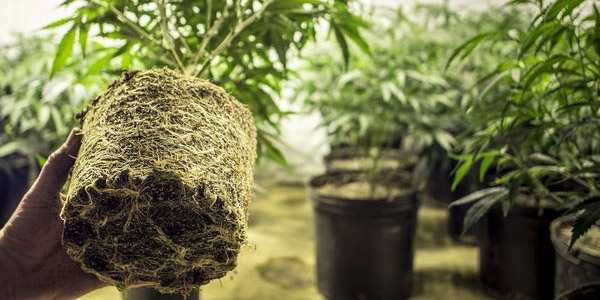
The greater the root zone you have the less often you’ll need to water your cannabis.
Five Signs To Look For When Your Cannabis Plant Is Under or Over-Watered
As you can see — there’s a lot to consider when it comes to learning how to irrigate your cannabis plants properly.
Now, let’s touch upon the subject of signs to look for to determine if your weed plants need more or less water. Remember, the majority of problems that arise when cultivating marijuana are visual. In other words — you can see when things are a miss.
Without further ado, here are the five crucial signs to keep an open eye on.
1. Drooping Leaves
Drooping cannabis leaves are the tell-tale sign of an under-watered weed plant.
If your cannabis plant’s leaves are drooping, you must provide an appropriate amount of water immediately.
Besides drooping leaves, underwatered cannabis plants will:
- Look lifeless
- Exhibit weak stems or branches
- Fall over
Unless corrected, your cannabis plant will die. Remember, the longer you take to correct this common mistake — the longer it takes for your weed plant to bounce back to life.

If you’re cannabis starts drooping it’s probably underwatered.
2. Curling or Clawing Leaves
Curling or clawing leaves may look like a nutrient toxicity issue (nitrogen), but it may occur when overwatering marijuana plants.
If you provide too much water, the plant cannot breathe (respirate), which forces the leaves to curl or claw.

If the leaves on your cannabis plant start clawing, there’s a good chance they’re overwatered.
3. Yellowing Leaves
Yellowing leaves are another sign of nutrient deficiency (nitrogen or iron). However, your marijuana plants may exhibit yellowing leaves if you overwater.
Remember, too much water decreases the cannabis plant’s ability to breathe. Ultimately, the roots will begin to rot, which leads to a cascade of nutrient-related problems.

Yellowing leaves could be a sign of overwatering.
4. Brown Leaf Edges
Another common symptom of underwatering, especially in soilless media like coco coir, is brown leaf edges.
Brown leaf edges occur when salt builds up in the medium. Remember, hydroponic-based media requires salt-based nutrients, which are far more concentrated than an organic nutrient.
Therefore, it’s never recommended to allow soilless media to dry out. If you allow hydroponic-based media to dry — the salt accumulation will explode within the media, which causes:
- Rapid dehydration
- Immediate pH imbalance
- Excess nutrient levels
As you can see, the result of brown leaf edges may prove to be game over for your cannabis plant unless quickly corrected.

If you see brown leaf edges on your cannabis plant it probably has an excess salt build up from underwatering.
5. Topsoil Problems
Many beginners experience topsoil problems because of their natural desire to care for their beloved marijuana plants. However, too much TLC isn’t recommended — especially when it comes to watering.
Topsoil problems occur when you overwater your weed plants. Here’s a list of issues that you will see if you don’t get your overwatering addiction in check:
- The sudden appearance of fungus gnats
- Mold on the topsoil
- Stem rot
Remember, if the top layer of soil is saturated — you must allow enough time for it to dry. If you continue to saturate your weed plants — they will eventually die.
Do you want to avoid these common watering mistakes? If so, read our guide — How to Stop Under and Overwatering Cannabis Plants.

If you overwater your plants you might get topsoil problems like these pesky fungus gnats.
Learn How To Implement an Irrigation Strategy In Your Cannabis Garden
Now that you understand the fundamentals of watering cannabis — it’s time to step it up a notch.
Now is the time to learn how to turn irrigation plans into a reality. More often than not, simple irrigation strategies work wonders for cultivators learning how to grow weed.
The easiest watering methods for beginners are:
- Hand watering
- Setting up a drip line
Are you ready to learn how to use these tried-and-true irrigation methods? Read our guides — How to Hand Water Cannabis Plants From Start to Finish (Coming Soon) and How to Set Up a Drip Irrigation System For a Successful Harvest (Coming Soon). Both of these guides cover hand watering and setting up a drip line in soil and soilless mediums.
Once you’ve mastered these irrigation methods, it’s time to move forward with more advanced techniques with hydroponics, such as:
- Drain to waste (or recycle)
- Deep water culture
- Nutrient film technique
If you’re ready for blazing-fast vegetation speed and mind-blowing harvests, read our guides — How to Set Up and Grow Cannabis in a Drain-To-Waste System (Coming Soon), How to Set Up and Grow Cannabis in Deep Water Culture (Coming Soon), and How to Set Up and Grow Cannabis in the Nutrient Film Technique (Coming Soon).
Once you master the art of watering your cannabis crop, the result will always be the same — happy plants that yield ounces of trichome-covered buds.
